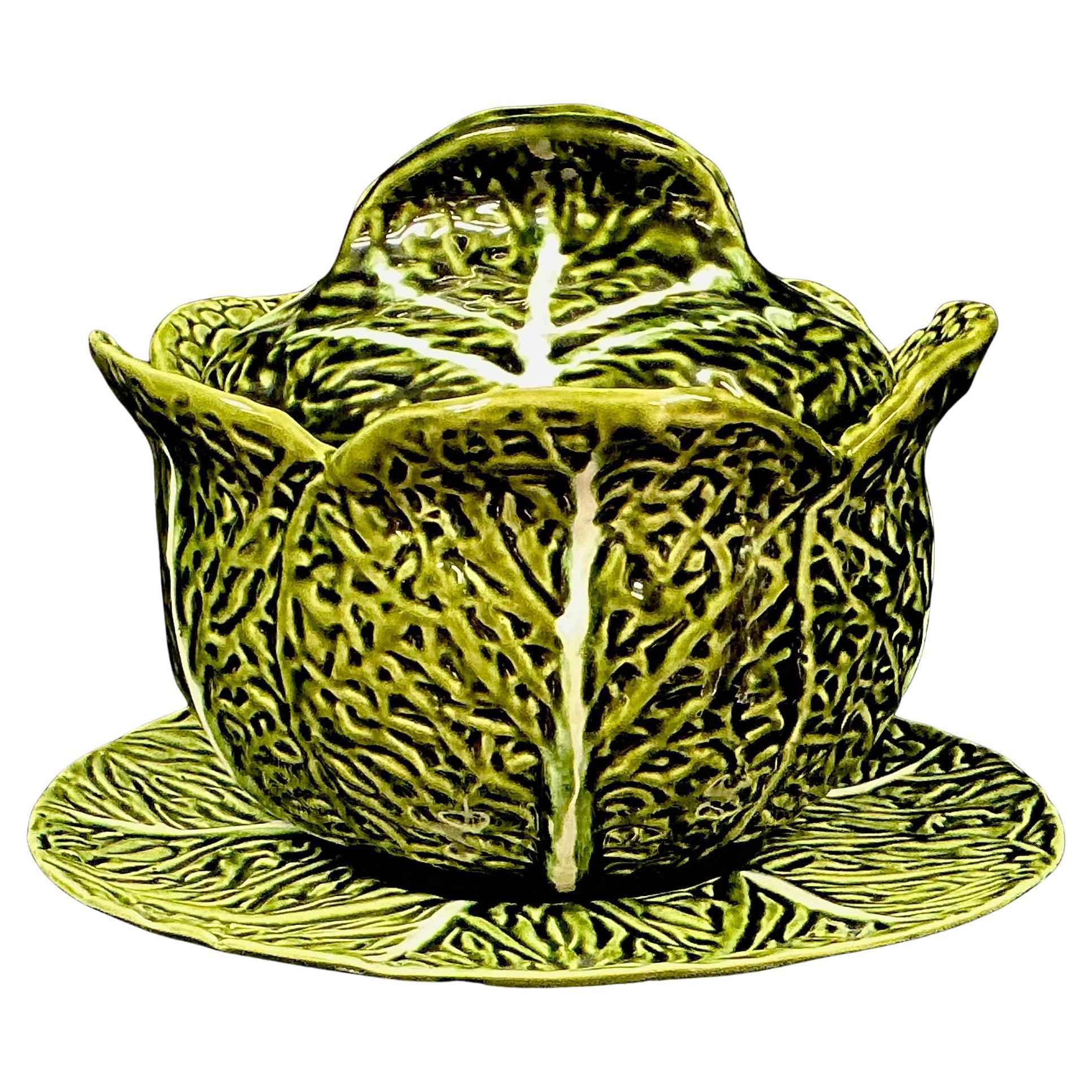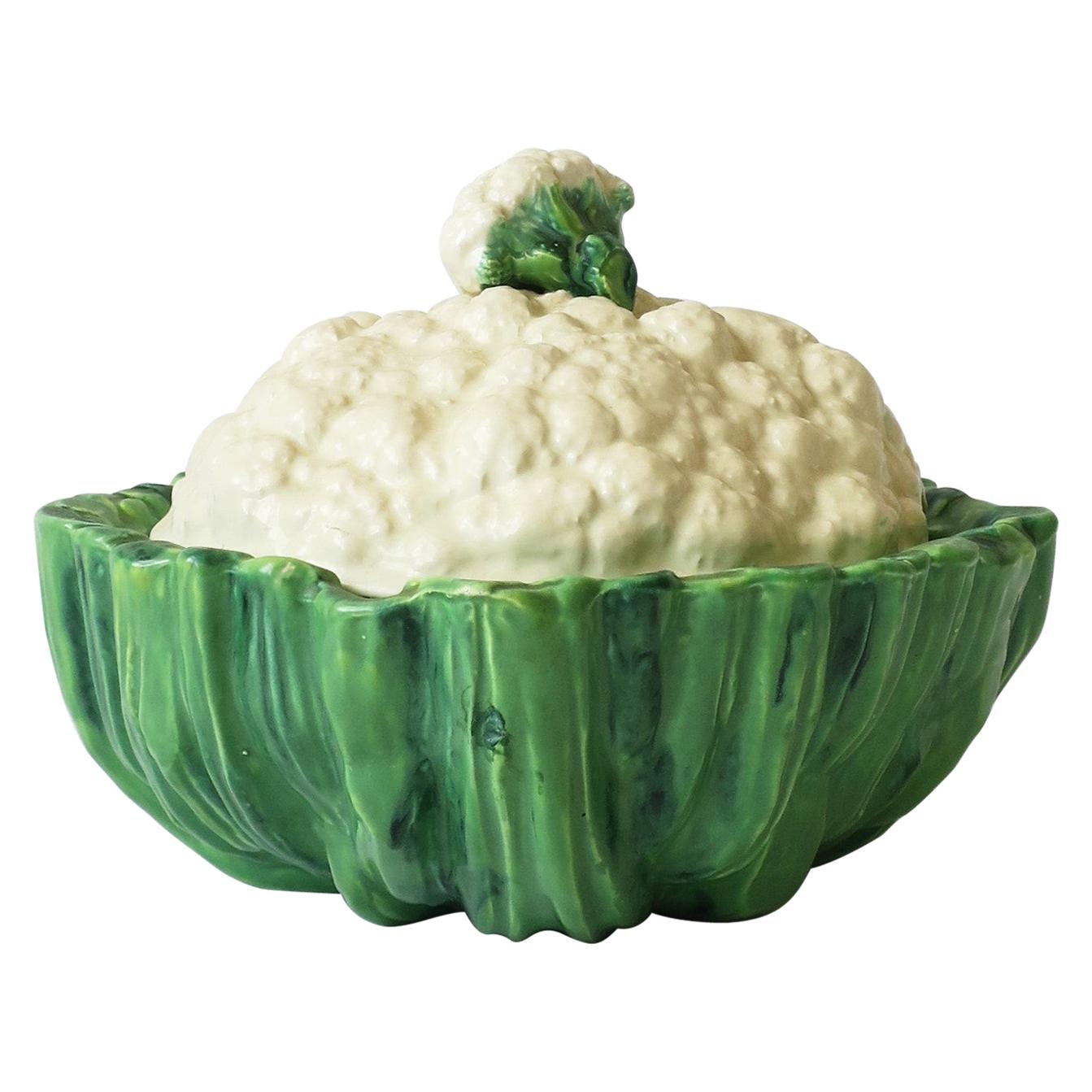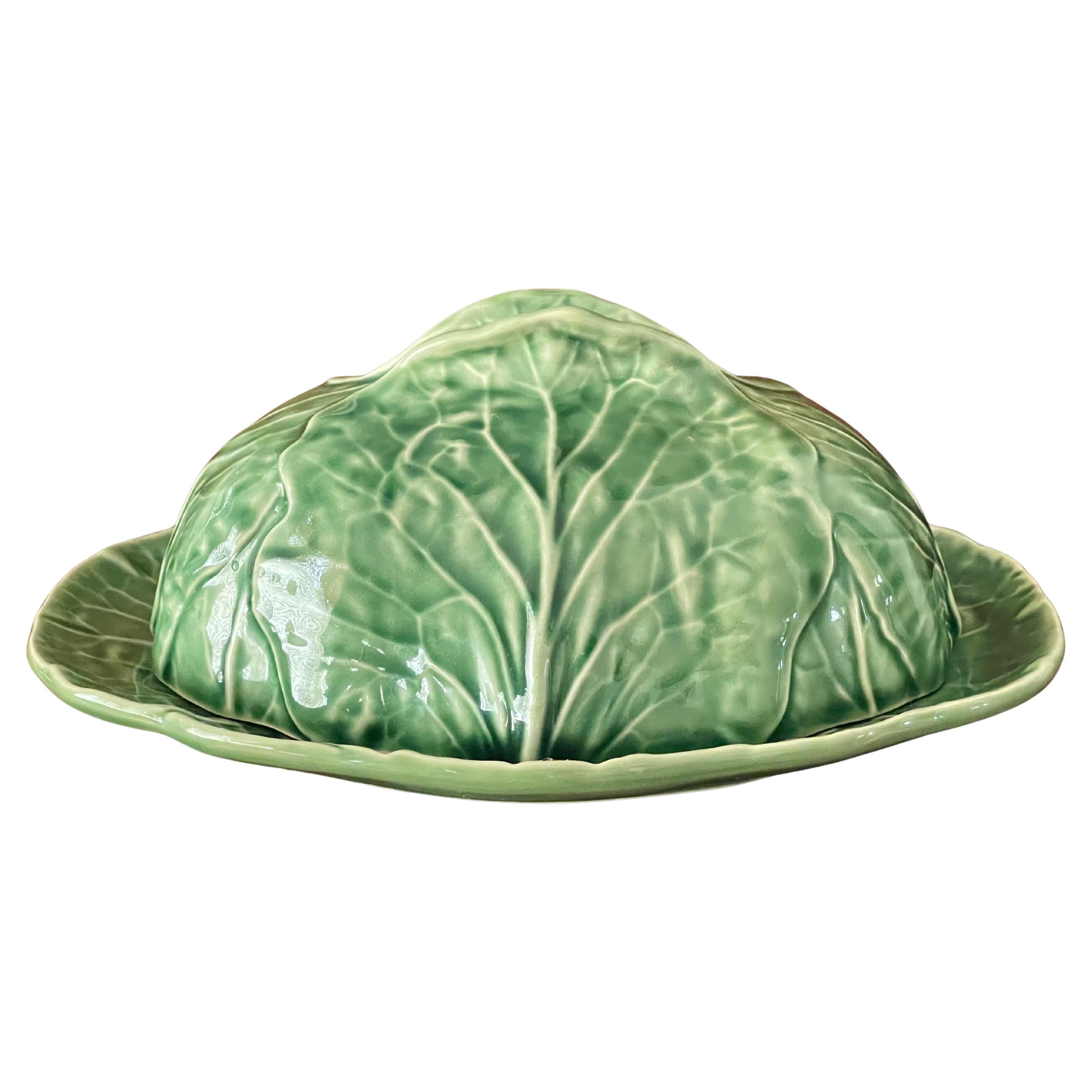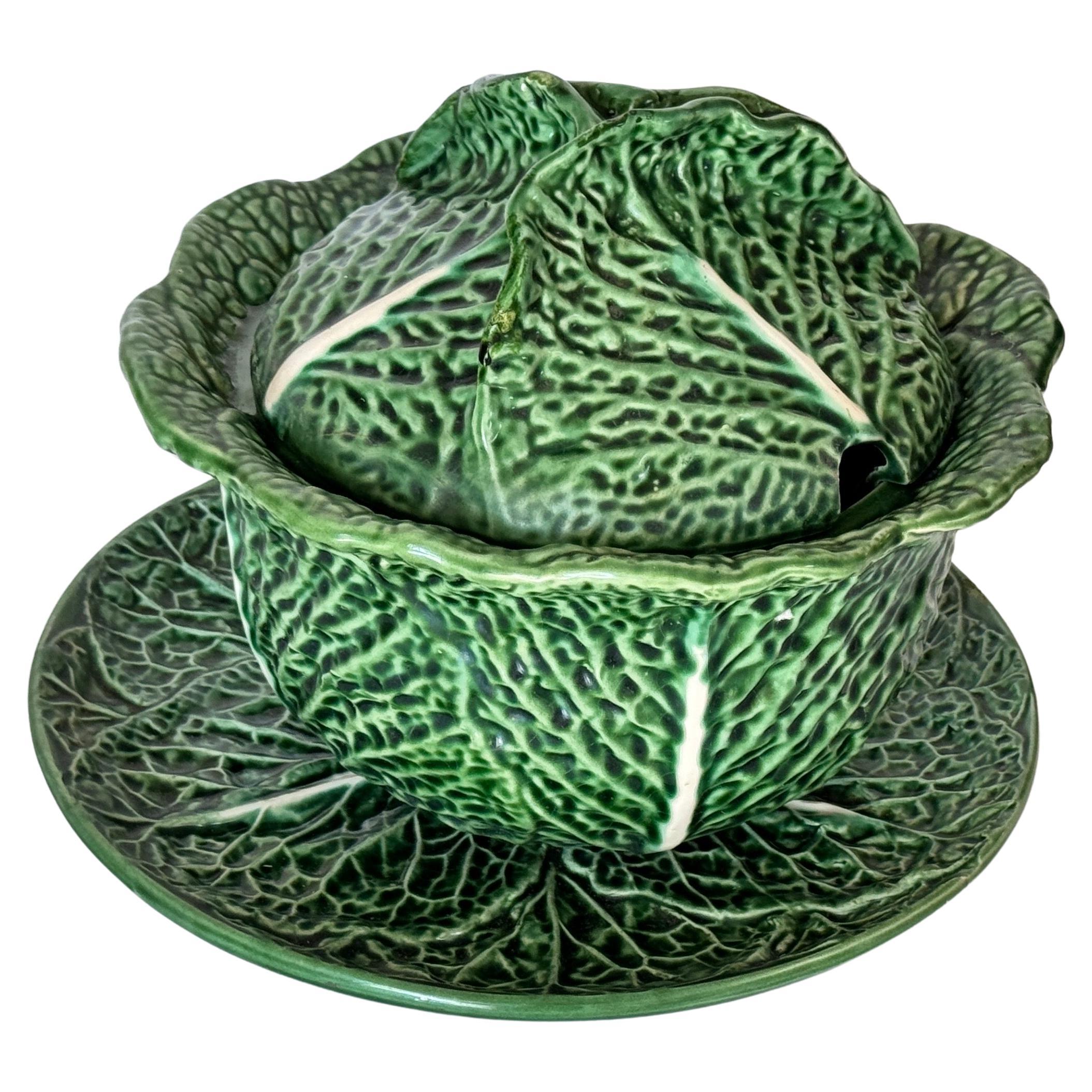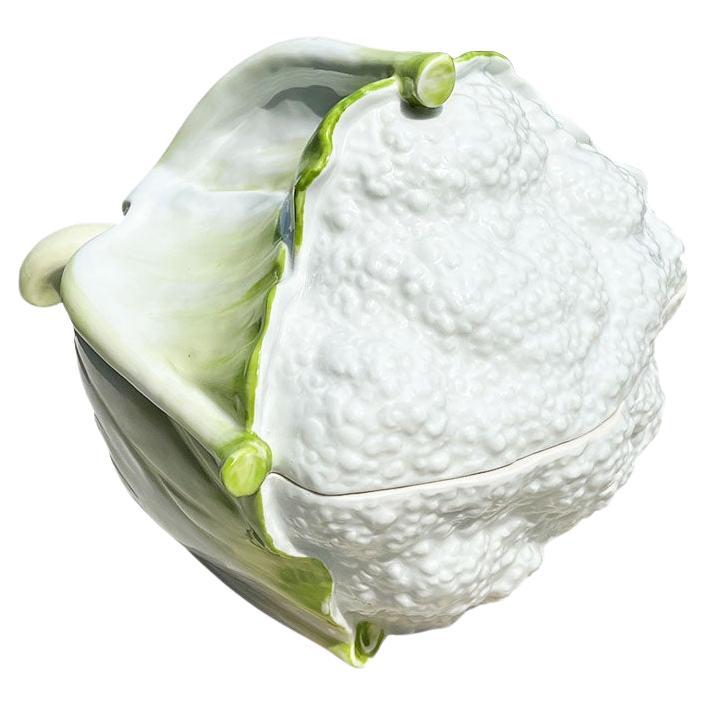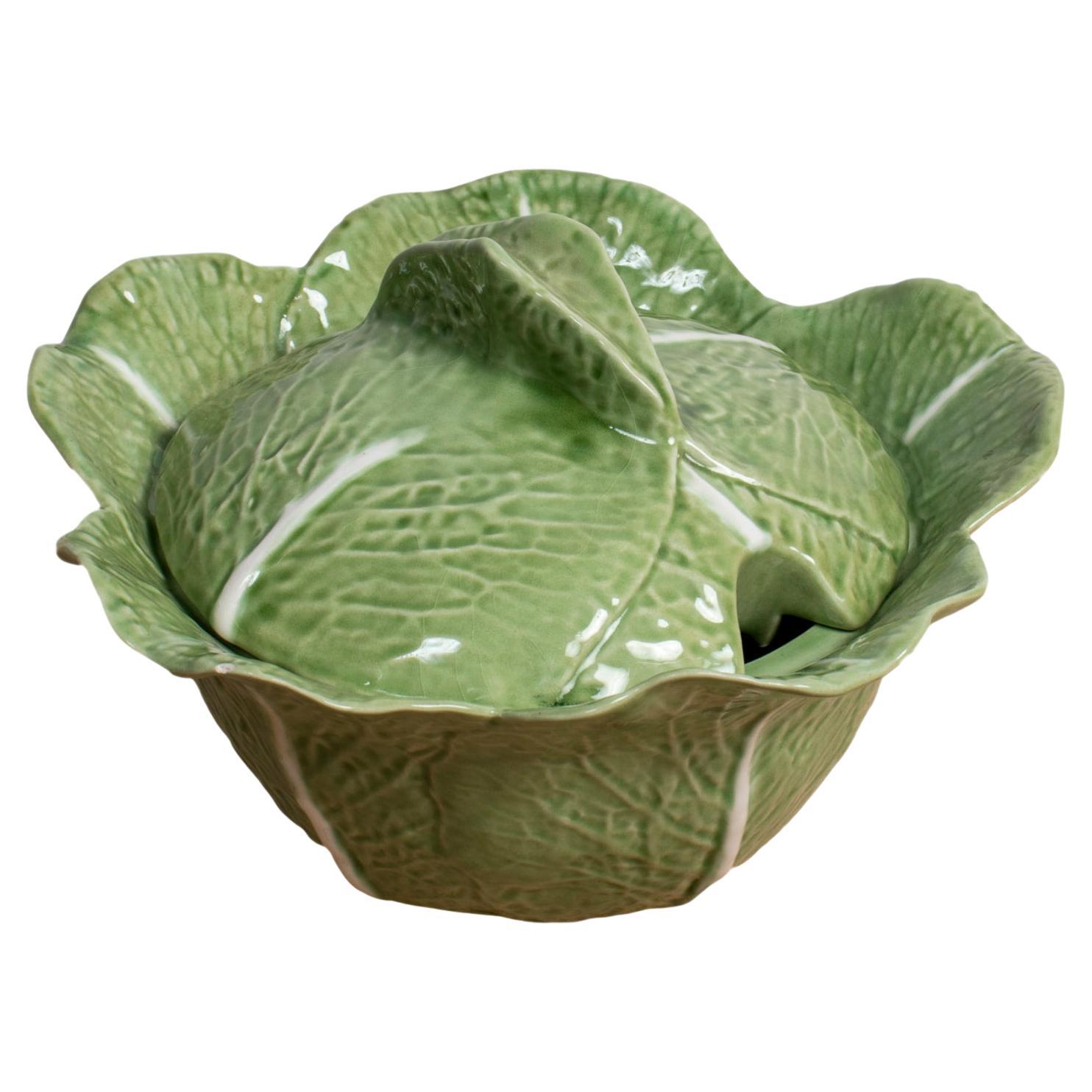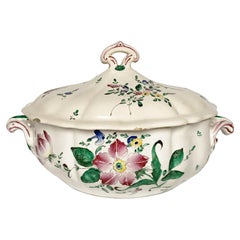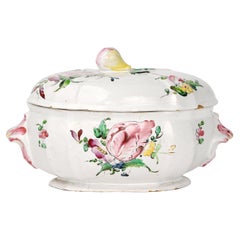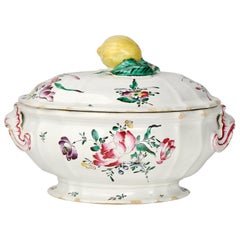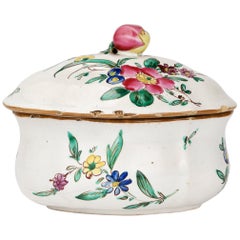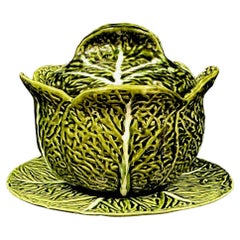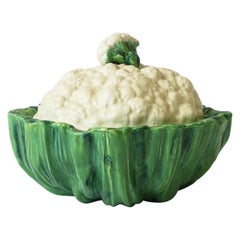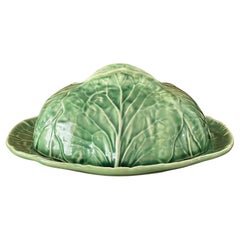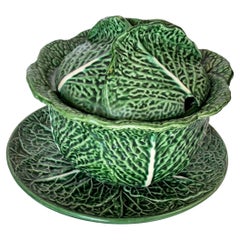Items Similar to Small Earthenware Cabbage-Shaped Soup Tureen, Gaetano Bonato, late 19th century
Video Loading
Want more images or videos?
Request additional images or videos from the seller
1 of 18
Small Earthenware Cabbage-Shaped Soup Tureen, Gaetano Bonato, late 19th century
$1,902.42
£1,416.86
€1,600
CA$2,668.24
A$2,926.35
CHF 1,509.24
MX$34,957.76
NOK 19,141.79
SEK 17,957.17
DKK 12,192.24
About the Item
Small earthenware cabbage-shaped soup tureen
Gaetano Bonato
Bonato Manufacturing
Angarano, late 19th century
It measures: 5.91 in in height x 7.87 x 8.07 (15 cm × 20 × 20.5)
It weighs: 0.24 lb (1.09 kg)
State of conservation: intact
This small earthenware soup tureen features a naturalistic form inspired by savoy cabbage, with a careful rendering of the delicate overlapping of the leaves, whose protruding ribs serve as convenient gripping points to remove the lid. The body is decorated with a range of greens simulating the different stages of ripening of the vegetable, with darker tones in the shaded areas between the open leaves.
The taste for trompe-l'œil soup tureens, that is, made with illusionistic shapes inspired by nature, is typical of 18th-century European ceramic production, particularly in France, but also in northern Italy. An emblematic example is the famous service which was made in Faenza by the Ferniani manufactory for Maria Amalia of Saxony, who visited the city in 1738, and which is now preserved in the Ville Casa Grandi (F. Liverani, Maioliche settecentesche dell'Emilia Romagna, 1981, nn. 34-35).
Another significant comparison is the cabbage-shaped tureen made of maiolica produced by the Felice Clerici manufacture, now part of the Applied Art collections of the Castello Sforzesco in Milan (R. Ausenda, ed., Musei d'Arti Applicate, tomo II, Milan 2001, p. 494, no. 442).
Similar artifacts were also made in the Veneto manufactories, including those of Viero, Barettoni, Bonato, Passarin, and Zen of Nove, active especially in the second half of the 19th century, with stylistic outcomes of great interest.
The presence of the "GB and star" mark, painted in iron red, confirms the attribution of the work to the Gaetano Bonato manufacture, active in the late 19th and early 20th centuries (N. Stringa in R. Ausenda, G. Bojani, eds., La ceramica dell'Ottocento nel Veneto e in Emilia Romagna, Modena 1998, p. 154, nn. 7-8).
The Bonato manufactory fitted into the context of Bassano's flourishing ceramic production, where, beginning in the mid-19th century, several factories dedicated initially to terracotta and later to earthenware sprang up in the wake of the English fashion. These included the one founded by Gio Batta Marcon, that of Raffaele Passarin, and, in Angarano, that of Gaetano Bonato. Bonato, already active as a painter at the historic Antonibon factory, opened his own manufactory near Ponte Vecchio in 1883, as reported by Giuseppe Corona. The latter, in describing the 1884 National Exhibition for the publisher Sonzogno, also mentions Bonato's ceramic production. Some ten years later, a chronicler of the Gazzetta di Venezia wrote: "We found a tiny little factory, where eight or ten workers were working to produce flower vases, flower basins, little shoes, trinket holders..." (Bassano industries, Gazzetta di Venezia, August 12, 1894).
The manufactory became well known for producing ornamental vases, phytomorphic and zoomorphic tureens, figurative groups, baskets, risers, cups, and popular plates. It participated in major international exhibitions, including the 1900 Paris World's Fair (L'Italie industrielle et artistique à Paris 1900. Exposition Universelle, Milan, Capriolo & Massimino, 1900, p. 468), even gaining official recognition, including the gold medal at the 1901 Genoa Exposition.
Bibliography:
R. Ausenda - G. C. Bojani, ed, La ceramica dell'ottocento nel Veneto e in Emilia Romagna, Modena 1998, p. 154, nn. 7 and 8.
R. Ausenda, ed, Musei d'Arti Applicate, Tomo II, Milan 2001, p. 494 n. 442
F. Liverani, Maioliche settecentesche dell'Emilia Romagna ,1981
Nineteenth-century ceramics in Veneto and Emilia Romagna, Modena 1998, p. 154, nos. 7 and 8.
- Creator:Gaetano Bonato (Maker)
- Dimensions:Height: 5.91 in (15 cm)Width: 0.99 in (2.5 cm)Depth: 7.88 in (20 cm)
- Style:Other (Of the Period)
- Materials and Techniques:Ceramic,Enameled
- Place of Origin:
- Period:
- Date of Manufacture:Circa 1890
- Condition:Wear consistent with age and use. Intact.
- Seller Location:Milano, IT
- Reference Number:1stDibs: LU4352246966242
About the Seller
4.3
Vetted Professional Seller
Every seller passes strict standards for authenticity and reliability
Established in 1860
1stDibs seller since 2018
21 sales on 1stDibs
Associations
International Confederation of Art and Antique Dealers' Associations
- ShippingRetrieving quote...Shipping from: Milano, Italy
- Return Policy
Authenticity Guarantee
In the unlikely event there’s an issue with an item’s authenticity, contact us within 1 year for a full refund. DetailsMoney-Back Guarantee
If your item is not as described, is damaged in transit, or does not arrive, contact us within 7 days for a full refund. Details24-Hour Cancellation
You have a 24-hour grace period in which to reconsider your purchase, with no questions asked.Vetted Professional Sellers
Our world-class sellers must adhere to strict standards for service and quality, maintaining the integrity of our listings.Price-Match Guarantee
If you find that a seller listed the same item for a lower price elsewhere, we’ll match it.Trusted Global Delivery
Our best-in-class carrier network provides specialized shipping options worldwide, including custom delivery.More From This Seller
View AllAncient Maiolica Tureen Ferretti Manufacture, Lodi, Circa 1770 - 1780
By Antonio Ferretti
Located in Milano, IT
Maiolica tureen
Antonio Ferretti Manufacture
Lodi, Circa 1770 - 1780
Maiolica polychrome decorated “a piccolo fuoco” (third fire).
It measures 9.06 in in height x 13.39 in x 9.84 i...
Category
Antique 1770s Italian Rococo Soup Tureens
Materials
Maiolica
Italian Maiolica Tureen, Rubati Manufacture, Milan, circa 1770-1780
By Pasquale Rubati
Located in Milano, IT
Maiolica tureen
Pasquale Rubati Manufacture
Milan, circa 1770 - 1780
Maiolica polychrome decorated “a piccolo fuoco” (third fire).
It measures 6.69 in x 11,02 x 8.26 (17 x 28 x ...
Category
Antique 1770s Italian Rococo Ceramics
Materials
Maiolica
Italian Maiolica Ancient Tureen, Lodi, 1770-1780
By Antonio Ferretti
Located in Milano, IT
Maiolica tureen
Antonio Ferretti Manufacture
Lodi, circa 1770-1780
Maiolica polychrome decorated “a piccolo fuoco” (third fire).
It measures 9.05 x 12.59 x 9.05 in (23 x 32 x 23 cm)
...
Category
Antique 1770s Italian Rococo Ceramics
Materials
Maiolica
Italian Maiolica Ancient Sugar Bowl, Lodi, 1770-1780
By Antonio Ferretti
Located in Milano, IT
Maiolica sugar bowl
Antonio Ferretti Manufacture
Lodi, Circa 1770-1780
Maiolica polychrome decorated “a piccolo fuoco” (third fire).
It measures 3.54 x 4.52 x 3.54 in (9 x 11,5 x 9 cm)
Weight: 0.394 lb (0.179 kg)
State of conservation: small and slight chips on the edges.
The small sugar bowl has a swollen and ribbed body resting on a flat base. The cap-shaped lid follows the rib of the container and is topped with a small knob in the shape of a two-colored fruit.
The sugar bowl is painted “a piccolo fuoco” (third fire) with the characteristic floral motif of bunches and isolated semis.
An example which closely corresponds to this one is kept at the Civic Museum in Lodi (G. Gregorietti, Maioliche di Lodi, Milano e Pavia, Catalogo della Mostra, Milano, 1964 n. 137).
This decorative style represented a strong point of the Lodi factory, which established itself thanks to the vivid nature of the colors made possible by the introduction of a new technique perfected by Paul Hannong in Strasbourg and later introduced by Antonio Ferretti to Italy. The production process, called “piccolo fuoco” (third fire), allowed the use of a greater number of colors than in the past; in particular, the purple of Cassius, a red made from gold chloride, was introduced. Its use allowed for many more tones and shades, from pink to purple.
The Ferretti family started their maiolica manufacturing business in Lodi in 1725.
The forefather Simpliciano started the business by purchasing an ancient furnace in 1725 and, indeed, we have evidence of the full activity of the furnaces starting from April of the same year (Novasconi-Ferrari-Corvi, 1964, p. 26 n. 4). Simpliciano started a production of excellence also thanks to the ownership of clay quarries in Stradella, not far from Pavia. The production was so successful that in 1726 a decree of the Turin Chamber came to prohibit the importation of foreign ceramics, especially from Lodi, to protect internal production (G. Lise, La ceramica a Lodi, Lodi 1981, p. 59).
In its initial stages, the manufacture produced maolicas painted with the “a gran fuoco” (double fire) technique, often in turquoise monochrome, with ornamentation derived from compositional modules in vogue in Rouen in France. This was also thanks to the collaboration of painters like Giorgio Giacinto Rossetti, who placed his name on the best specimens next to the initials of the factory.
In 1748 Simpliciano made his will (Gelmini, 1995, p. 30) appointing his son Giuseppe Antonio (known as Antonio) as universal heir. After 1750, when Simpliciano passed away, Antonio was directly involved in the maiolica factory, increasing its fortunes and achieving a reputation on a European level. Particularly important was the aforementioned introduction in 1760 of the innovative “a piccolo fuoco” (third fire) processing, which, expanding the ornamental repertoire with Saxon-inspired floral themes, was able to commercially compete with the German porcelains that had one of its most renowned offerings in the naturalistic Deutsche Blumen. Antonio Ferretti understood and promoted this technique and this decoration, proposing it in a fresher and more corrective version, less linked to botanical tables, both with or without contour lines, as well as in purple or green monochrome. After efforts to introduce more industrial production techniques to the sector succeeded, even the Ferretti manufacture, in the last decade of the eighteenth century, started heading towards decline despite its attempts to adapt production to neoclassical tastes.
In 1796 the Napoleonic battle for the conquest of the Lodi bridge over the Adda definitively compromised the furnaces. Production resumed, albeit in a rather stunted manner, until Antonio's death on 29 December 1810. (M. L. Gelmini, pp. 28-30, 38, 43 sgg., 130-136 (for Simpliciano); pp. 31 sgg., 45-47, 142-192 (for Antonio).
Bibliography
G. Gregorietti, Maioliche di Lodi Milano e Pavia Catalogo della Mostra, Milano, 1964 n. 137;
C. Baroni, Storia delle ceramiche nel Lodigiano, in Archivio storico per la città e i comuni del circondario e della diocesi di Lodi, XXXIV (1915), pp. 118, 124, 142; XXXV (1916), pp. 5-8;
C. Baroni, La maiolica antica di Lodi, in Archivio storico lombardo, LVIII (1931), pp. 453-455;
L. Ciboldi, La maiolica lodigiana, in Archivio storico lodigiano, LXXX (1953), pp. 25 sgg.;
S. Levy, Maioliche settecentesche lombarde e venete, Milano 1962, pp. 17 sgg.;
A. Novasconi - S. Ferrari - S. Corvi, La ceramica lodigiana, Lodi 1964, ad Indicem; Maioliche di Lodi, Milano e Pavia (catal.), Milano 1964, p. 17;
O. Ferrari - G. Scavizzi, Maioliche italiane del Seicento e del Settecento, Milano 1965, pp. 26 sgg.;
G. C. Sciolla, Lodi. Museo civico, Bologna 1977, pp. 69-85 passim; G. Lise, La ceramica a Lodi, Lodi 1981;
M. Vitali, in Storia dell'arte ceramica...
Category
Antique 1770s Italian Rococo Ceramics
Materials
Maiolica
Ancient Italian Maiolica Tureen Milano, 1770 circa
By Felice Clerici, Pasquale Rubati
Located in Milano, IT
Maiolica tureen “allo struzzo” (ostrich decoration)
Milan, Felice Clerici or Pasquale Rubati factory, circa 1750-1780
Measures: 9.25 in x 12.79 in x 10.23 in (cm 23.5 x cm 32.5 x cm 26)
lb 4.78 (kg 2.17)
State of conservation, a felûre consolidated inside with slight edge chipping restored.
In Milan in the 18th century two Majolica warehouses were opened, the first, by Felice Clerici, in 1745, the second in 1756 by Pasquale Rubati.
Traditionally this type of decoration has been attributed to the Pasquale Rubati factory. In reality the motif “allo struzzo”, one of the clearest examples of how the taste for chinoiserie met with considerable success during the 18th century, had been produced, in specimens of greater or lesser quality, by both Milanese manufactories.
This Maiolica tureen has a swollen and ribbed oval bowl, rests on an extroflexed foot and shows stirrup handles.
The tri-color ornament, in the typical tones of Japanese "Imari" decorations, shows an idealized oriental landscape that develops around a perforated rock and has a willow tree with long lance-shaped leaves framing the long-legged bird figure. The ornamentation is enhanced by decorative elements such as butterflies, small florets and a vase with a thin flowery stem.
The lid is ribbed with a pear-shaped knob on top.
The decoration was called in the Milanese manufactories "allo struzzo" (ostrich decoration) and this refers to the oriental figure Xian He or the crane, symbol of longevity, here losing its symbolic value. It is hypothesized that among some 16th century engravings...
Category
Antique 1770s Italian Chinoiserie Ceramics
Materials
Maiolica
Italian Maiolica Cup Ferretti Lodi, circa 1770 - 1780
By Antonio Ferretti
Located in Milano, IT
Maiolica puerperal cup
Antonio Ferretti Manufacture
Lodi, Circa 1770 - 1780
Maiolica polychrome decorated “a piccolo fuoco” (third fire).
It measures: 4.3 x 6.8 x 5.3 in (11 x 17,5 x 13,5 cm)
Weight: 0.78 lb (358 g)
State of conservation: some closed pass-through fêlures on the cup, barely visible on the outside. Some use chips on the edge of the lid, two of which are more marked.
From about the mid-sixteenth century, the puerperal soup tureen or puerperal cup became one of the most popular wedding gifts in central Italy. As an auspicious symbol, it replaced the birth table (“desco da parto”) which, on the occasion of high-ranking marriages, from the thirteenth century, had been painted by famous artists, especially in Tuscany.
In France this same tureen is called "écuelle de mariée", as it is given to spouses as a sign of fertility.
During the eighteenth century this custom spread even outside Italy to all social levels. Depending on availability and rank, it was made of different materials: precious metals, maiolica, porcelain, glass, pewter, etc.
Beginning in the mid-twentieth century, the custom of this symbolic homage gradually disappeared, although famous designers such as Gio Ponti and Giuseppe Gariboldi, even as recently as the 1940s, revisited a model of a small puerperal soup bowl for the Ginori and, also in Italy in 1940, in a national competition for young potters, one of the themes of the test was indeed a modern model of a puerperal cup as an auspicious gift.
This particular cup was also called a "service cup" or "puerperal vase" or "stuffed cup" - the windows were sealed with straw to prevent drafts of air for women in labor.
In the eighteenth century the line of the puerpera cup was simplified, so much so that it took the form of a small tureen with two handles - the typical broth cup...
Category
Antique 1770s Italian Rococo Ceramics
Materials
Maiolica
You May Also Like
Majolica Cabbage Leaf Soup Tureen With Lid and Underplate
Located in Bradenton, FL
20th Century Faiancas Belo Portuguese Majolica Cabbage Leaf Soup Tureen with Lid and Underplate. Features a charming and sculptural cabbage-form ceramic soup tureen with matching lid...
Category
Mid-20th Century Portuguese Rustic Soup Tureens
Materials
Majolica
Tureen Bowl Cauliflower Cabbage Vegetable
Located in New York, NY
A very beautiful off-white and green pottery cauliflower vegetable soup or stew tureen, Trompe l'Oeil style, circa mid-20th century. Tureen has a 'cauliflower' lid with knob and a gr...
Category
Mid-20th Century Unknown Soup Tureens
Materials
Ceramic, Pottery
Vintage Bordallo Pinheiro Ceramic Cabbage Dish w Cover
Located in Boca Raton, FL
Organic modern ceramic dish with cover by Portuguese Bordallo Pinheiro cabbage motiv. Signed at bottom. Great decorative tableware piece and ...
Category
Vintage 1950s American Organic Modern Ceramics
Materials
Ceramic
$110 Sale Price
43% Off
1970s French Ceramic Cauliflower Soup Tureen with Lid and Matching Base
Located in Auribeau sur Siagne, FR
1970s French Ceramic Cauliflower Soup Tureen with Lid and Matching Base – Realistic & Decorative
Description:
This charming and original French ceramic soup tureen, crafted in the 1...
Category
Vintage 1970s French French Provincial Garniture
Materials
Ceramic
Early 18th Century Antique Porcelain Chelsea Cauliflower Tureen with Lid
Located in Oklahoma City, OK
A beautiful antique covered tureen in the shape of a cauliflower. This piece is very old but shows very little signs of wear for its age. This trompe l'oeil ceramic dish is in the shape of a large cauliflower in green and white. The lid or the top shows the vegetable lying on its side with tight white florets and ribbed leaves painted in shades of green. A small notch at one end is for resting the matching white ceramic ladle...
Category
Antique 18th Century Ceramics
Materials
Porcelain, Paint, Ceramic
$5,200 Sale Price
20% Off
Vintage Caldas da Rainha Portuguese Cabbage Tureen with Lid, signed F. Mendes
Located in Birmingham, AL
A delightful vintage Portuguese majolica tureen with lid, handcrafted in the 1950s by F. Mendes in Caldas da Rainha, the historic heart of Portuguese pottery. This charming tureen, s...
Category
Antique Mid-19th Century Portuguese Serving Pieces
Materials
Majolica
